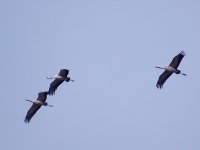
I conclude by showing the mouth of the Manzanares in the Jarama by its left bank from Casa de Peña Blanca to the mouth, shortly before Presa del Rey.
89 Storks and a couple of peregrine falcons overflown me.
Once on the river I saw mallards, chiffchaffs, a lot of blue tits and less great tits. I saw two female redstarts, and two robins too
The pond of Soto de las juntas, one of my usual birding areas, stood to my left. There was not great crested grebes. It is the first time I see none of them in this pond since at least 2008. However I saw a teal, whose population has grown a lot this year. In the pond there were a moorhen and the ubiquitous coots, a little grebe and a black-necked one.
Back to the river I saw this penduline tit nest. The trees are without leaves in winter, and then this days I've been seeing many nests, but not one penduline tit.
My approach to river caused the flight of a mallard although a couple of teals remained quieter.
It is impossible not to see the multitude of chiffchaffs in the river.
And the surprise of the day came with this flock of 15 cranes. It is assumed that Madrid has not wintering population. It was January 2nd and obviusly is not the moment of entry or exit migration, so they have to have roost not very far away. The nearest roost are Castrejón reservoir at 80 km to the southwest, at the same distiance to the south is also the northern edge of the endorheic lakes Villacañas-Cigüela, or a little further the Rosarito Reservoir 150 Km to the west.
The usual distance betwen the roost and the feeding fields are from 2 or 3 km to more than 30 Km. But the known roost are minimun 80 km. Perhaps there are not known roosts nearer.
And when I was already arriving to Jarama river I saw gadwalls. This year I have seen few of them.
The rabbit population is very large in all the area and they support the hight population of black kytes that arive in march
And here I finally reached the mouth. These are the last 50 meters of the Manzanares. What It is seem at the bottom among the reeds is the Jarama river.
Already in the Jarama river I saw a little grebe at the left, and in the right a moorhen and a coot. Background ducks were difficult to identify perhaps gadwalls.
And here I took back Jarama river a little, as I will publish next week.
More in:
https://birdingmanzanares.blogspot.com



